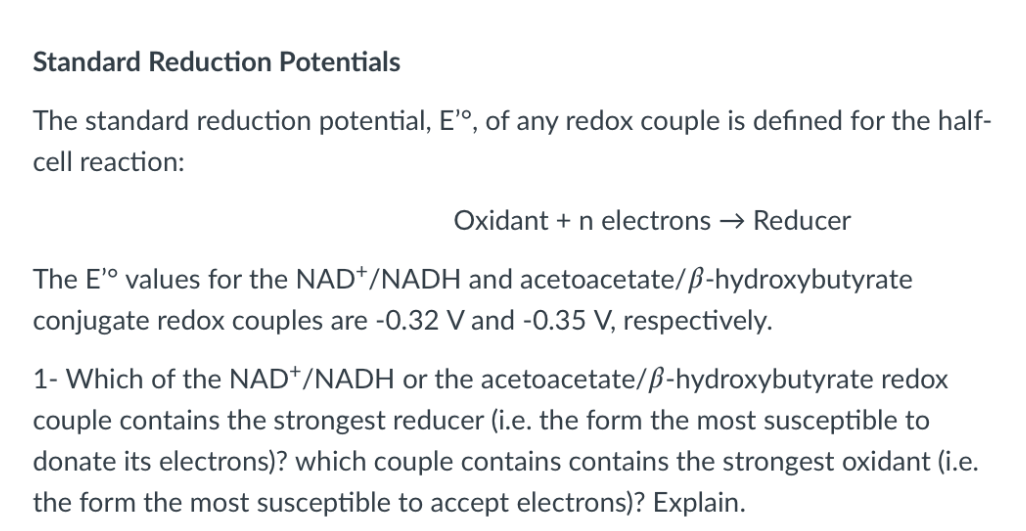Standard Reduction Potentials The standard reduction potential, E'º, of any redox couple is defined for the half- cell reaction: Oxidant + n electrons → Reducer The E'º values for the NAD*/NADH and acetoacetate/ß-hydroxybutyrate conjugate redox couples are -0.32 V and -0.35 V, respectively. 1- Which of the NAD*/NADH or the acetoacetate/ß-hydroxybutyrate redox couple contains the strongest reducer (i.e. the form the most susceptible to donate its electrons)? which couple contains contains the strongest oxidant (i.e. the form the most susceptible to accept electrons)? Explain.
Standard Reduction Potentials The standard reduction potential, E'º, of any redox couple is defined for the half- cell reaction: Oxidant + n electrons → Reducer The E'º values for the NAD*/NADH and acetoacetate/ß-hydroxybutyrate conjugate redox couples are -0.32 V and -0.35 V, respectively. 1- Which of the NAD*/NADH or the acetoacetate/ß-hydroxybutyrate redox couple contains the strongest reducer (i.e. the form the most susceptible to donate its electrons)? which couple contains contains the strongest oxidant (i.e. the form the most susceptible to accept electrons)? Explain.
Chemical Principles in the Laboratory
11th Edition
ISBN:9781305264434
Author:Emil Slowinski, Wayne C. Wolsey, Robert Rossi
Publisher:Emil Slowinski, Wayne C. Wolsey, Robert Rossi
Chapter32: Voltaic Cell Measurements
Section: Chapter Questions
Problem 2ASA
Related questions
Question

Transcribed Image Text:Standard Reduction Potentials
The standard reduction potential, E'°, of any redox couple is defined for the half-
cell reaction:
Oxidant + n electrons → Reducer
The E'° values for the NAD*/NADH and acetoacetate/ß-hydroxybutyrate
conjugate redox couples are -0.32 V and -0.35 V, respectively.
1- Which of the NAD*/NADH or the acetoacetate/ß-hydroxybutyrate redox
couple contains the strongest reducer (i.e. the form the most susceptible to
donate its electrons)? which couple contains contains the strongest oxidant (i.e.
the form the most susceptible to accept electrons)? Explain.
Expert Solution
This question has been solved!
Explore an expertly crafted, step-by-step solution for a thorough understanding of key concepts.
This is a popular solution!
Trending now
This is a popular solution!
Step by step
Solved in 3 steps

Knowledge Booster
Learn more about
Need a deep-dive on the concept behind this application? Look no further. Learn more about this topic, chemistry and related others by exploring similar questions and additional content below.Recommended textbooks for you

Chemical Principles in the Laboratory
Chemistry
ISBN:
9781305264434
Author:
Emil Slowinski, Wayne C. Wolsey, Robert Rossi
Publisher:
Brooks Cole

Chemistry: Principles and Reactions
Chemistry
ISBN:
9781305079373
Author:
William L. Masterton, Cecile N. Hurley
Publisher:
Cengage Learning


Chemical Principles in the Laboratory
Chemistry
ISBN:
9781305264434
Author:
Emil Slowinski, Wayne C. Wolsey, Robert Rossi
Publisher:
Brooks Cole

Chemistry: Principles and Reactions
Chemistry
ISBN:
9781305079373
Author:
William L. Masterton, Cecile N. Hurley
Publisher:
Cengage Learning


Chemistry: An Atoms First Approach
Chemistry
ISBN:
9781305079243
Author:
Steven S. Zumdahl, Susan A. Zumdahl
Publisher:
Cengage Learning

Chemistry
Chemistry
ISBN:
9781305957404
Author:
Steven S. Zumdahl, Susan A. Zumdahl, Donald J. DeCoste
Publisher:
Cengage Learning

Chemistry: The Molecular Science
Chemistry
ISBN:
9781285199047
Author:
John W. Moore, Conrad L. Stanitski
Publisher:
Cengage Learning